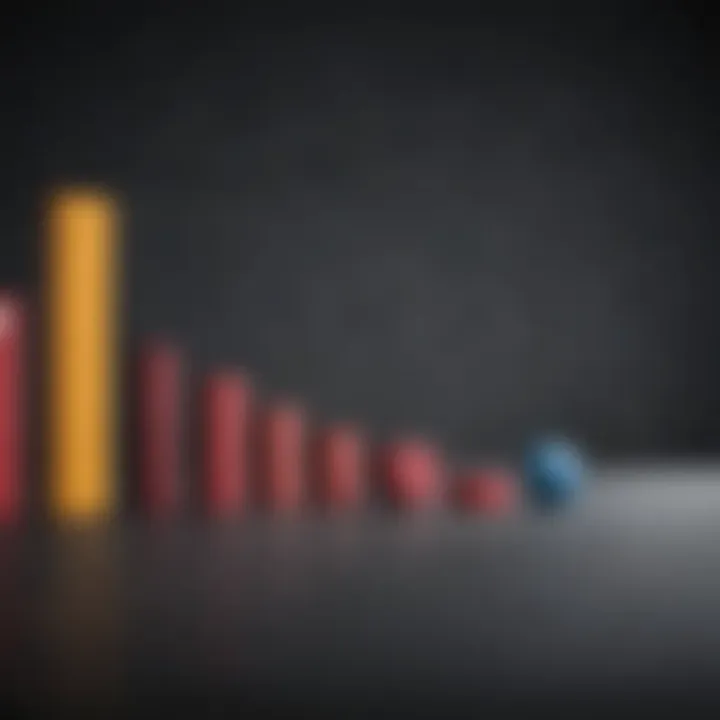Insights from the Latest Inflation Report and Its Impact


Intro
Today’s economic climate is tangible evidence of the intricate dance between various forces at play, with inflation taking center stage. The recent inflation report stirs the waters of financial discourse, presenting data that every investor should pay attention to. Where does the economy currently stand, and what can the numbers reveal about future trends? By examining the report in detail, we aim to provide insights that inform strategies for navigating investments amid changing inflation metrics.
Inflation affects almost all sectors of the economy. From consumers to businesses, everyone feels the pinch—or, conversely, benefits from these changes. As we delve into the latest findings, we’ll not only dissect the numbers but also explore the tricky waters of investment strategies influenced by these trends. This analytical exploration is not just for the seasoned investor; even those new to the financial landscape will find valuable nuggets of wisdom that assist in making informed decisions.
Let's chart the territory ahead and highlight some key concepts that will guide our discussion.
Understanding Inflation
Inflation is more than just a number; it’s a crucial part of our economic landscape that impacts various facets of life, from buying a loaf of bread to investing in the stock market. Analyzing inflation helps us grasp how purchasing power evolves over time, guiding both consumers and investors in making informed decisions. Understanding this topic is particularly relevant in an age when inflation rates seem to fluctuate more than ever.
In this article, we aim to dissect the current inflation report, allowing readers to dissect both immediate and long-term implications. This deep dive reveals not only the core aspects of inflation but also the ripple effects it can create in everyday life and the broader economy. By understanding these nuances, one can better navigate the sometimes murky waters of financial planning and investment.
Defining Inflation
Inflation can be defined as the rate at which the general level of prices for goods and services rises, subsequently eroding purchasing power. In simpler terms, if the inflation rate is 2%, something that costs $100 today will cost $102 a year from now. It’s important to note that this is not a uniform increase; not all prices rise at the same rate. For instance, while the cost of groceries may climb, the price of electronics may remain stable or even decline.
To illustrate, imagine a scenario where your usual coffee shop raises the price of your favorite brew, while your monthly streaming subscription stays the same. You experience a hike in coffee costs but an unchanged bill elsewhere; this paints a clearer picture of how inflation is felt differently in various sectors. Inflation also ties back to the broader economy—it can be influenced by factors such as money supply, consumer demand, and even global events.
Historical Trends of Inflation Rates
Looking back over the decades, history shows that inflation rates have not always moved in lockstep. For example, the 1970s brought about a surge of inflation, often called , characterized by stagnant economic growth combined with high prices. That was a stark reminder of how quickly conditions can shift and how critical it is to keep an eye on emerging trends.
In recent years, we’ve seen inflation rates fluctuate in response to a variety of catalysts:
- Post-2008 Financial Crisis: After this turmoil, inflation remained relatively low for several years as economies struggled to recover.
- Pandemic Effects: The COVID-19 pandemic sparked unique pressures on supply chains, influencing price changes dramatically.
- Current Climate: Recent reports unveil inflationary pressures driven by economic recovery efforts, reshaping how we view daily expenditures.
As we analyze the current inflation report, understanding these historical contexts give us a clearer lens to evaluate present circumstances. This awareness proves valuable—not just for deciphering why prices have surged or dipped but for predicting potential future trends, allowing investors to strategize accordingly.
Key Components of the New Inflation Report
Understanding the key components of the new inflation report is vital for both novice and experienced investors alike. These essential elements serve as building blocks for interpreting the broader implications of inflation trends on the economy, ultimately aiding in informed decision-making. The report offers a wealth of data, revealing not only the current state of inflation but also shedding light on core inflation measures and how different sectors contribute to price changes across the board.
A comprehensive analysis of these components helps investors gauge potential risks and opportunities, providing a roadmap for navigating the complex financial landscape. By breaking down the report entirely, one gains deeper insights into the mechanics of inflation and its intricate ties to economic performance.
Current Inflation Rate
The current inflation rate is perhaps the most talked-about metric in the inflation report. This figure is the percentage increase in the price of goods and services over a specified period, usually one year. It gives a snapshot of the economic reality most consumers and businesses face. A higher inflation rate generally suggests that the purchasing power of money is decreasing, leading to greater costs for everyday essentials.
This latest report indicates a current inflation rate of around 5.4%. While this figure may seem alarming at first glance, it's essential to put it into context by comparing it to historical rates. Over a decade, average inflation hovered around 2%. Therefore, a significant uptick in inflation raises eyebrows, compelling both policymakers and investors to act or, at the very least, to strategize for potential consequences.
Core Inflation Metrics
Core inflation metrics provide a more nuanced look at inflation trends by stripping away volatile items such as food and energy prices. This approach allows economists, investors, and policymakers to better understand underlying inflation trends without the distortive effects of sudden price changes in these sectors.
Recent numbers show that core inflation rests at 4.3%. This measurement presents a crucial insight; while the overall inflation rate may reflect sharp spikes due to energy costs, core measurements give a sense of the persistent inflationary pressures in the economy. Consequently, when strategizing investments or interpreting monetary policy, focusing on these core metrics is essential since they usually drive long-term trends rather than temporary fluctuations.


Sector Contributions to Inflation
Different sectors contribute to inflation levels in unique ways. The inflation report breaks down these contributions by sector, such as housing, healthcare, transportation, and consumer goods. For example, the housing market poses a significant driver, accounting for nearly 30% of total inflation in recent reports.
In contrast, healthcare costs continue to rise at an alarming rate, significantly impacting inflation levels. Similarly, the supply chain disruptions post-COVID have caused price hikes in transportation costs, which trickle down to other industries.
Understanding the specific contributions of these sectors is crucial. Investors may want to avoid sectors with persistent inflation pressures while potentially capitalizing on those that are more stable. By carefully examining these dynamics, one can not only track inflation better but also make smarter, more targeted investment choices.
Factors Influencing the Current Inflation Trends
Understanding the factors that drive current inflation trends is crucial for both investors and consumers. Inflation rates fluctuate due to several underlying elements, and grasping these influences helps individuals anticipat their financial moves. With prices rising or falling based on various circumstances, it’s vital to identify specific causes and understand how they interconnect. This section delves into key components like supply chain disruptions, energy prices, consumer demand, and government policies, shedding light on their roles in shaping inflation trends.
Supply Chain Disruptions
Supply chain disruptions have been a hot topic, especially in post-pandemic recovery discussions. When goods can’t move smoothly from suppliers to consumers, it creates bottlenecks that lead to delays and increased costs. For instance, a delay in shipping containers might mean higher prices for electronics or furniture, just to name a few. This rise in costs doesn't just stop at retail; it cascades through other sectors like manufacturing and transportation.
The ripple effect is significant. Companies may choose to pass on these costs to consumers. As a result,
- Prices rise for a range of products.
- Inflation rates shoot up because of these heightened costs.
- Stockpiling of goods may occur, leading to shortages.
Understanding these disruptions helps predict economic shifts and is vital for strategizing investments.
Energy Prices and Their Impact
Energy prices can sway inflation more than many realize. They’re like the canary in the coal mine for economic health. A steep increase in oil prices can send shockwaves through the economy. Higher energy costs affect everything from fuel for cars to the electricity powering our homes. This leads to a general rise in prices across the board, making it more difficult for consumers to manage their budgets.
Moreover, energy prices are volatile. Disruptions in oil production, geopolitical tensions, or shifts towards renewable energy sources can all cause dramatic changes. Investors should stay vigilant, as increasing energy costs might predict further inflation. Prices soar, and so do:
- Transportation costs
- Supply costs for businesses
- Consumer prices for goods and services
Consumer Demand Trends
Consumer demand plays an integral role in inflation. When people want to buy more, prices can rise correspondingly. However, this is not just about a simple increase in demand. Factors like consumer confidence, income levels, and prevailing economic conditions influence buying behavior.
Positive consumer sentiment often leads to higher spending, and conversely, when confidence wanes, spending drops. Fluctuating demand can lead to temporary price hikes when supply fails to keep up. This scenario highlights a broader picture:
- Market responsiveness — Businesses must adapt to changing demand.
- Stock levels — Higher demand can empty shelves, pushing prices up further.
- Global economic ties — Changes in one region can impact another.
Government Policies and Fiscal Measures
Lastly, government policies and fiscal measures greatly affect inflation trends. Policy decisions—like changing interest rates or implementing stimulus packages—can either cool down or fan the flames of inflation. For instance, lowering interest rates may encourage more spending, driving prices up, while increasing rates could tighten spending and contain inflation.
Tax policies and regulations also matter. For instance:
- Increased taxes on businesses might prevent price hikes by limiting how much companies can charge.
- Trade tariffs often raise costs for imported goods, fuelling inflation further.
Policies are often intertwined with broader economic goals, and their impact on inflation can be both direct and indirect.


"Understanding the underlying factors of inflation not only informs investment choices but also equips consumers to make better financial decisions."
By dissecting these elements, it becomes evident that inflation isn't quite a standalone issue. It weaves through various layers of the economy, responding to an array of influences, making it an essential topic for savvy investors and consumers who wish to stay informed.
Economic Implications of the New Inflation Report
Understanding the economic implications of the new inflation report is critical. It helps outline the landscape of financial decisions for various stakeholders, including policymakers, businesses, and individual consumers. As inflation rates fluctuate, they have far-reaching effects across multiple facets of the economy. What might seem like a mere percentage point change can send ripples through the financial markets, consumer spending, and wage structures. These implications are crucial for investors seeking to safeguard their portfolios and devise long-term strategies.
Effects on the Financial Markets
Financial markets react sharply to changes in inflation reports. When inflation climbs, investors often brace for the possible interventions by central banks, like adjusting interest rates. Historically, rising inflation may lead to higher costs of borrowing, which tends to dampen corporate profits. For stock markets, this could lead to a sell-off in equities. On the flip side, certain sectors, like utilities and consumer staples, might prove more resilient, as they often pass costs onto consumers.
It's also noteworthy to consider how bonds behave amid inflationary pressures. Many investors view bonds as safe bets, but when inflation rises, the value of fixed interest payments diminishes. Here’s a brief overview:
- Higher Interest Rates: Common response from central banks, leading to bond price declines.
- Sector Rotation: Investors may shift to sectors that historically perform well during high inflation, like real estate or commodities.
- Market Volatility: Increased uncertainty often leads to fluctuations in stock prices across various sectors.
"An inflation rise does not just mean higher prices; it also signals changes in investor sentiment and expectations."
Impacts on Consumer Behavior
As inflation trickles down to the average consumer, spending habits tend to shift. People become more cautious about where they put their money, prioritizing essentials over discretionary items. When consumers feel the pinch from rising prices, this could lead to a significant drop in demand for non-essential goods and services. Furthermore, businesses may respond by cutting costs, which can result in layoffs or reduced hours for workers, creating a cycle of diminished purchasing power.
The dynamics unfold as follows:
- Increased Savings Rates: When inflation looms, consumers may begin to save more, fearing economic instability.
- Price Sensitivity: Consumers might switch to lower-priced alternatives, affecting brand loyalty.
- Buy Now, Pay Later Options: A rise in these payment options as consumers spread out costs to cope with inflation.
Influence on Income and Wage Growth
Lastly, the connection between inflation and wages can be quite intricate. On one hand, inflation can prompt calls for higher wages as workers push to keep pace with rising costs. Employers, facing increased labor costs, may respond in one of two ways: by increasing wages to retain talent or by downsizing to manage expenditures.
It's essential to keep an eye on wage growth trends, as they influence purchasing power significantly. If real wages (adjusted for inflation) decline, consumers will have to tighten their belts further. Here’s what you might see:
- Pressure on Employers: They may feel compelled to adjust salaries to curb turnover and maintain morale.
- Potential for Stagflation: When inflation rises while economic growth stalls, creating an environment of stagnant demand and rising prices.
- Sector-Specific Growth: Industries like technology may see quicker wage adjustments due to competition for skilled workers.
Guidance for Investors in a High-Inflation Environment
Navigating through a high-inflation environment can feel like walking a tightrope strung high above ground. Investors face unique challenges, as inflation alters the landscape of financial markets and affects purchasing power. Having a clear strategy becomes paramount. This section should arm you with knowledge and practical steps that resonate with both novices and seasoned investors trying to make sense of it all.
Investment Strategies During Inflationary Periods
Investors need to be proactive when inflation takes center stage. It’s crucial to adapt investment strategies to mitigate risk while capitalizing on potential opportunities. Here are some effective approaches to consider:
- Adjust your asset allocation: Traditionally, equities have been a go-to for many, but it’s wise to diversify into real assets like real estate or commodities which typically retain value during inflation spikes.
- Look for stocks with pricing power: Companies that can pass on costs to consumers without losing demand often thrive in inflationary times. Think sectors like essentials, preferred by investors looking for stability.
- Explore inflation-linked bonds: These financial instruments, like Treasury Inflation-Protected Securities (TIPS), offer returns that adjust according to changes in the inflation rate, providing a safety net amidst rising costs.
Investment is as much about readiness as it is about strategy. Flexibility in your approach can make a profound difference.
Asset Classes to Consider


When inflation creeps up, certain asset classes can serve as safe havens or hedge against the diminishing value of money. Below are some noteworthy options:
- Real Estate: Physical properties often appreciate over time, yielding rental income that tends to rise along with inflation.
- Precious Metals: Gold and silver have historically been seen as a hedge against inflation, preserving value when currencies falter.
- Commodities: Investing in commodities such as oil, grain, and other necessities can safeguard your portfolio, as their prices usually soar in inflationary climates.
- Equities in certain sectors: Sectors such as utilities and healthcare tend to provide more consistent returns, as these essential services remain in demand regardless of inflation rates.
Risk Management Techniques
A sound investment strategy must include risk management. In turbulent times, knowing how to protect yourself can mean the difference between profit and loss:
- Regularly review and adjust your portfolio: Establishing a routine to assess your investments allows you to identify areas needing adjustment based on prevailing inflation trends.
- Set stop-loss orders: This tool can safeguard against dramatic market swings, minimizing potential losses if a downturn occurs unexpectedly.
- Consider hedging: Utilizing options or futures can be effective. For instance, buying put options can serve as insurance against plummeting stock prices.
Investing well amidst inflation demands vigilance and adaptability. Remember, it’s not just about surviving but thriving—even when the economic weather isn’t fair.
By understanding these strategies, asset classes, and risk management techniques, investors can better position themselves in a high-inflation environment. The goal is to make informed decisions that enhance wealth and safeguard assets, no matter the economic climate.
Long-term Consequences of Inflation Trends
Understanding the long-term consequences of inflation trends is essential for both policymakers and investors. As inflation evolves, its impacts ripple through various sectors of the economy, affecting everything from individual purchasing power to governmental fiscal strategies. It’s not just a number we find on a report—it has profound implications that can either propel or constrain economic growth. Investors need to anticipate how these trends can influence their portfolios while consumers must consider how their cost of living may shift.
Potential Shifts in Economic Policy
In response to prolonged inflation, we may witness significant shifts in economic policy. Governments might pivot towards tighter monetary policies, which could include raising interest rates to curb excess liquidity in the market. While this could slow borrowing and spending, it’s a double-edged sword. Higher interest rates can deter investments, but they may stabilize prices in the long run.
Another noteworthy consideration is fiscal policy adjustments. Should inflation persist, governments might feel pressured to tweak tax policies or even reconsider subsidy allocations to maintain social equity. As the adage says, “Desperate times call for desperate measures.” This directly points to how urgent the situation can become if inflation is left unchecked.
"Inflation is the crabgrass in your savings." - Robert Kilian
Future Projections for Inflation Rates
When we project future inflation rates, we must navigate a complex web of factors. The interplay of global supply chains, consumer behavior, and geopolitical tensions all contribute to these forecasts. As seen in historical data, inflation does not merely rise and fall in an arbitrary manner; it often reacts to external shocks. For instance, disruptions in oil supply can lead to sudden price increases that could shift inflation trajectories almost overnight.
Analysts utilize various models to predict these trends, but it’s crucial to remember that they are just that—models. They often rely on assumptions that may not hold in the face of unexpected events. Investors looking at the landscape must remain agile and be prepared for shifts that could challenge their current strategies.
Global Economic Influences
This inflationary landscape isn't confined to one country's borders. Global economic influences play a pivotal role in domestic inflation rates. For example, rising commodity prices in one region can trigger inflation spikes worldwide. Countries interlinked through trade find themselves in a delicate balance where rising inflation in one area can lead to similar issues elsewhere.
Additionally, the pace of recovery from economic downturns post-pandemic provides another layer of complexity. If economies grow too rapidly, they can put strains on existing capacities, pushing prices even higher.
In short, it’s not only a matter of looking within one’s own financial borders. Investors and consumers must consider the broader, interconnected economic landscape if they wish to navigate the tricky waters of inflation effectively.
Culmination and Key Takeaways
Understanding the implications of the new inflation report is crucial for both individuals and institutions. Inflation, in its essence, affects everything from consumer purchasing power to organizational growth strategies. This article has explored various facets of the latest inflation trends, offering insights that can guide sound financial decisions. By digesting the findings, readers can appreciate how inflationary pressures influence their investments and broader economic policies.
Summary of Key Findings
To encapsulate the key takeaways:
- Current Inflation Rate: The report spotlighted a notable fluctuation in the current inflation rate, which serves as a bellwether for economic health. Record highs can indicate rising costs for everyday goods and services, which may pinch consumers. Conversely, a gradual decrease could signal a stabilizing market.
- Core Inflation Trends: Beyond the headline figures, core inflation—removing volatile items like food and energy—provides a cleaner view of long-term trends. It’s the steady pulse of the economy, reflecting persistent inflation or deflation that can guide monetary policy.
- Sector Contributions: Different sectors bear varying impacts of inflation. For instance, the housing sector may show more resilience owing to higher demand, while consumer goods may feel the crunch quickly due to supply chain issues.
Final Thoughts on Navigating Inflation
As we navigate through this inflationary landscape, several strategies come into play. Savvy investors should:
- Re-evaluate Investment Portfolio: It might be prudent to diversify holdings to shield against inflation risks. Assets such as real estate or commodities often prove to be more resilient during such times.
- Monitor Economic Indicators: Keeping an eye on Federal Reserve policies or shifts in consumer sentiment can offer forewarnings about future inflation trends.
- Consider Inflation-Protected Assets: Treasury Inflation-Protected Securities (TIPS), for example, offer a direct hedge against inflation, adjusting your principal based on the Consumer Price Index.







